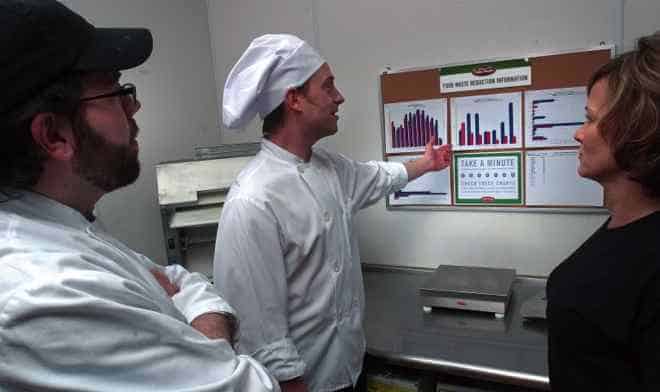Andrew Shakman had been working in the world of technology. A chance meeting put him on a path to becoming an expert the in the field of food waste.
Nearly ten years ago, he started thinking about how he could make a greater impact and stumbled onto the idea of weighing food waste. It was an idea that resonated with him. “There’s something that is very personal to food. There is a connection to anyone you meet through food,” said Shakman, Co-Founder and President, CEO of LeanPath. His journey has taken him to high profile institutions such as the MGM Grand Buffet, University of California, and University of Massachusetts to restaurant kitchens.
In the United States, as much as 40 percent of food is never eaten, according to estimates by the Environmental Protection Agency. Twenty-five percent of all freshwater and 300 million barrels of oil are used annually to produce food that is wasted, according to LeanPath. Food waste results in the loss of environmental resources as well as production of greenhouse gas emissions, and it means those in need are denied access to food that is being squandered. Shakman wanted to address this issue through a product-based solution to a problem.
In 2004, with two partners, Shakman formed LeanPath to provide a technology to track food waste and monitor the amount of food waste being produced. For years, the existence of waste wasn’t a secret but the drive to quantify the waste wasn’t present. He saw the collection of the data being a systematic approach to solving the problem. When it comes to pre-consumer waste, “It’s a strategic way to look at the problem,” said Shakman. The data “forces people to see what’s going on.” LeanPath produces devices that are installed in industrial kitchens to capture the amount of food waste. The device consists of a scale, an integrated camera, and a touch-screen user interface. He stressed though that technology alone will not address the food waste issue. “This is about culture and not technology…it’s about changing behavior,” said Shakman.
He points to the complex nature of the issue. “If this was a byproduct of single process, it would have changed,” said Shakman. One cause he cited for the waste was cultural behavior. For restaurants and food industry, he cited the fear of running out and need to create perfect displays. “There are some practices in which we throw out good food,” he said. This is partially driven by consumers wanting to see beautiful layouts and merchandising regardless of the time of the day, driving restaurants and stores to produce and display items even at times when there is little demand.
In recent years, there has been a greater focus on food waste. More people have transitioned to a western diet that places a greater emphasis on animal-based proteins. Land use patterns have changed. The price of oil, a key input for the agricultural industry, has risen. Food prices have increased and consumers have to spend a greater percentage of household budget on food. This, and the greater emphasis on sustainability driven partially by millennials, has increased the spotlight on food waste.
The importance of data in preventing waste is at the core of the Shakman’s approach but he thinks the key issue that still needs to be solved is “how you get a group of actors who do not have a fully aligned agenda to work together.” His work includes showing food industry executives the economic and environmental benefits of reducing waste. He also considers the foodservice industry to be the one of the key groups in this battle against food waste. They’ll have to be the ones to weigh the waste, create the data, and spend precious moments in the kitchen to create the base for better decisions for purchasing and managing the food to prevent wastage.













